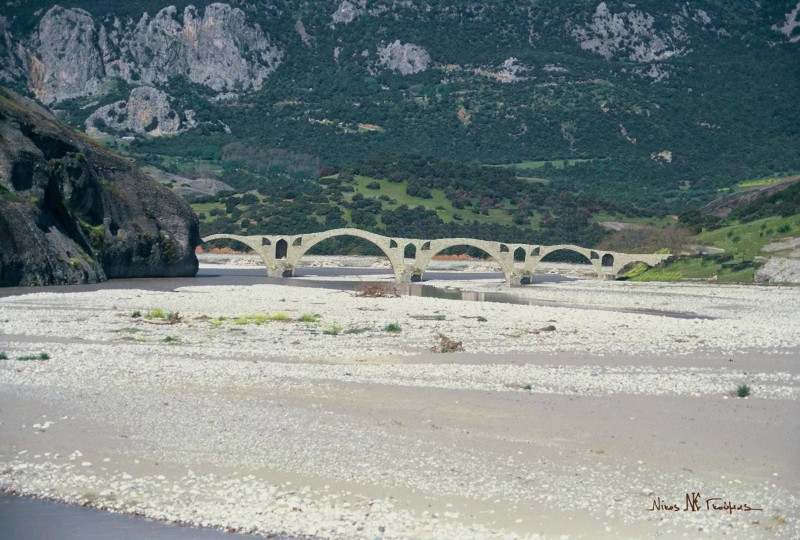In recent years, the Sarakina bridge was included in a program funded by the Region of Thessaly, for a total of 8.2 million euros
The legendary arched bridge of Sarakina was another loss from the passage of bad weather Daniel, located 3 kilometers south of Meteora.
Recently, maintenance and fixing works were completed by the region of Thessaly, however, it did not last due to the natural disaster that hit the area.
The bridge is a 16th century construction, it is mentioned by the researchers as the most important multi-arched bridge of Western Thessaly and it is assumed that it is the work of the then Metropolitan of Larissa and today’s Agios Bessarionos.
Historical evidence according to written testimonies:
1808. At the beginning of May, Albanian forces from Trikala, led by Velimbasis and Bekir, cross the Sarakina bridge, who go to join Albanian forces under the formidable Yusuf Arapi, who were guarding the Kryas Vrysis bridge next to Murgani. They had been attacked earlier by Dimitrios Vlachavas with three hundred charioteers, wanting to cut off the Turks’ communication with Epirus, while his brother, Papa-Thymios Vlachavas, was running to incite other captains in Olympus during the betrayed Revolution of May 1808.
1813. Pouqueville F. mentions Sarakina bridge in ruins. “at a distance of one and a half leagues from Rakoulies we meet the inn Kainourgios and from there the road diverges for half a league towards the village of Sarakina, below which we meet a ruined bridge over the great river of Hassia (Pineios)”
1817. Ioannis Oikonomou-Larisaios reports that near Sarakina there is a bridge, “half of which was demolished a few years before the descent of the river23.”
1855. The master craftsman Kostas Bekas from the village of Pramantas in Ioannina undertakes the project of reconstructing the half-damaged stone bridge, providing a solution to the problem of transportation and giving basis only to the functional purposes served by the bridge, disregarding the aesthetics of the new part.
Instead of the one damaged pedestal with the two arches on either side, K. Bekas erected two new pedestals while the deck became wooden, thus offering great relief and joy to the residents of the entire area, due to the reopening of the bridge.
Kostas Bekas was born around 1825 in Pramantas of Ioannina and died at the age of 75. In addition to the reconstruction of the bridge of Sarakina, he built the bridges of Klentini, Sarantaporos and Plaka in 1866. Such was his presence and the esteem they had for him, that in the area of Pertouli, when he was building the Bridge of Sarakina, they sang: ” A dress with a flare, Kostas Bekas wears it.”
However, the elements of nature again brought problems to the bridge and the importance of its existence is also testified by two written references at the beginning of the 20th century:
In October 1908, the rushing waters of Pinios carried away the wooden carrier of the bridge, as a result of which traffic was interrupted. In an article of the Trikala newspaper “Tharros” we read:
“The Sarakinas bridge, the only way to communicate with our city and the entire Aspropotamos more than 20 days ago, was destroyed and all that population cannot communicate. The public must take care of it quickly because it is unfair that so many people are complaining.”
Victor Dousmanis in his book Military Geography of Thessaly, in 1933, states:
In the section between Paraskevi and Sarakina, the Pinios narrows; here there is a Byzantine bridge known as the Sarakina bridge, which allows the connection from the plain to the mountainous area of the outflow channel of the Pinios. It is not necessary for there to be a bridge either in Sarakinan or in Kalambakan since the road from the last village to Malakasi and the passage of the Libra is mostly on the right bank of the river.
Source : 1. Nikolaos L. Goumas. Sarakina Kalambakas, as it appears in the written sources from its foundation to the end of the 19th century. Historical Events and monuments. 3rd Kalambaka Historical Conference 2007, Proceedings Volume 2, Genesis Publications, Kalambaka 2009.)
Source: Skai
I have worked as a journalist for over 10 years, and my work has been featured on many different news websites. I am also an author, and my work has been published in several books. I specialize in opinion writing, and I often write about current events and controversial topics. I am a very well-rounded writer, and I have a lot of experience in different areas of journalism. I am a very hard worker, and I am always willing to put in the extra effort to get the job done.











